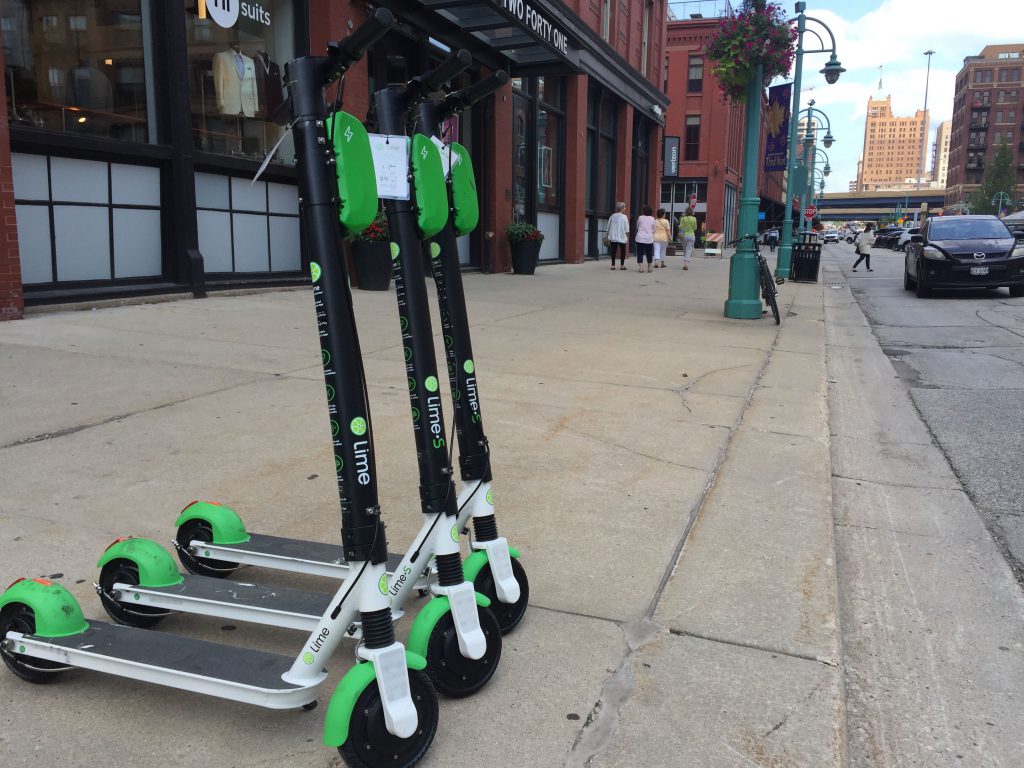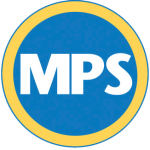Scooters Could Return to Milwaukee
Could return in 2021. In 2019, 350,130 rides taken, with 67 crashes.
Dockless electric scooters were the hot topic at Milwaukee City Hall for much of 2019. A pilot program was created as a one-year trial to see how the scooters would fare on city streets.
Ultimately 350,130 rides were taken, with the three participating companies reporting 67 crashes and 141 citizen complaints being submitted to the city. A Department of Public Works (DPW) survey at the end of 2019 generated 7,658 responses.
The 131-day pilot ended at the end of the year. Then a global pandemic took hold just as the city was expected to consider permanent regulations or another pilot program.
“We had created this report and a full recommendation earlier in the year, but obviously the pandemic put everything on hold,” said DPW transportation planner Kate Riordan.
“In 2021 we would like to bring scooters back,” she said. But instead of throwing open the doors to a standardized license program, DPW is recommending another pilot.
“We would like to see how scooters are used throughout the year,” said Riordan.
She said a series of key changes should be made to the pilot’s design including revising the fee structure and reconfiguring the placement zones.
Under the 2019 rules, authorized companies were able to place up to 250 dockless scooters each in an area east of Interstate 43 running from W. Oklahoma Ave. north to the city limits near W. Capitol Dr. that includes Downtown, the East Side, Brewers Hill, Bronzeville, Harambee, Bay View and a special cutout west to N. 22nd St. for Marquette University. The companies were able to place 100 additional scooters, bringing each company’s total fleet size to 350, in two additional zones (50 scooters per zone) that encompassed the rest of the city and were roughly divided by Interstate 94.
Riordan said DPW’s 2021 plan calls for reconfiguring the zones to try to spur more ridership across the rest of the city. It would also allow for more scooters outside of the greater downtown area. The 2019 pilot allowed a maximum of 1,000 scooters per company if certain performance metrics related to utilization were met.
“In terms of ridership, I think we were all surprised just how quickly people in Milwaukee took to scooters,” said multi-modal planning manager Michael Amsden. But a map of trips shows the vast majority were within Downtown, the Historic Third Ward, Lower East Side and lakefront.
The scooters were not uniformly loved. “Sidewalk riding tended to be the biggest complaint. That was a theme throughout the pilot,” said Riordan. DPW conducted 32 one-hour surveys at 18 locations that found just under 83 percent compliance with on-street riding requirements.
During the pilot DPW received 141 negative complaints, two-thirds of which dealt with sidewalk riding. The Mayor’s Office received 243 comments, 42 percent of which were negative. DPW reports that 52 percent of its comments were received and forwarded by Alderman Robert Bauman‘s office.
Of the 7,658 people that took DPW’s survey, 57% reported never having taken a scooter ride. Of those that took a trip on a scooter, 44% of survey respondents reported their last trip replaced a personal vehicle or rideshare (Uber/Lyft) trip. Forty percent reported it replaced a trip that would have otherwise been completed by walking. Just over seven percent reported it replacing a bus or streetcar trip.
“We really see this as an opportunity to increase transportation options,” said Amsden.
Of those that never rode a scooter but responded to the survey, 64 percent wanted to see scooters continue to be permitted. Those that took two or more trips had a 96 percent endorsement rate for bringing the vehicles back.
Operators reported 67 crashes, including 22 with no injuries. The Milwaukee Police Department reported six. The Milwaukee Fire Department reported responding to 12 incidents involving scooters, but lacked specific details.
Alderman Mark Borkowski asked if the streetcar tracks caused an issue. “I do not have have any specific reports of scooter and streetcar track issues,” said Riordan.
Companies imposed a variety of per-minute fees that are complicated to quickly compare. Urban Milwaukee performed an analysis of the different options last August.
The city also intends to require more educational events from providers and would include fleet-size bonuses for those that participate.
Other recommendations include painting parking zones in high-traffic areas, better detailing requirements for on-scooter safety notices and establishing a 24-hour idle time policy that would require removal of unused scooters.
Representatives of Lime, Spin and Bird, the three companies that participated in the 2019 pilot, were present at the virtual meeting, but were not allowed to speak. Bauman, the committee chair, did not ask any questions and cut the meeting short to get to a meeting with the mayor.
The Common Council would be required to adopt any future pilot program or licensing program.
A copy of the DPW presentation and report can be found on Urban Milwaukee.
Legislation Link - Urban Milwaukee members see direct links to legislation mentioned in this article. Join today
If you think stories like this are important, become a member of Urban Milwaukee and help support real, independent journalism. Plus you get some cool added benefits.
More about the Milwaukee scooter rollout
- Scooters Still Getting Riders in Winter, Raking in Cash - Jeramey Jannene - Jan 29th, 2025
- Milwaukee Scooter Ridership Soars, City Raking in Cash - Jeramey Jannene - Oct 29th, 2024
- Scooters Return To Milwaukee’s Streets, This Time Permanently - Jeramey Jannene - May 17th, 2024
- Scooters Could Net Milwaukee $400,000 Per Year - Jeramey Jannene - Mar 12th, 2024
- Full Legalization of Scooters Ends Up In City Budget - Jeramey Jannene - Nov 3rd, 2023
- Dockless Scooter Pilot Program Begins - Sophie Bolich - Sep 2nd, 2022
- Transportation: Milwaukee Wants Your Input on Future of Dockless Scooters - Jeramey Jannene - Oct 19th, 2021
- Transportation: Scooters Banned From Downtown - Jeramey Jannene - Aug 3rd, 2021
- Transportation: Dockless Scooters Will Return in 2021, With Restrictions - Jeramey Jannene - Apr 1st, 2021
- Transportation: Scooters Could Return To City In May - Jeramey Jannene - Mar 10th, 2021
Read more about Milwaukee scooter rollout here
Transportation
-
Congestion Pricing Cuts Air Pollution in New York City
 Dec 14th, 2025 by Jeff Wood
Dec 14th, 2025 by Jeff Wood
-
FTA Tells Milwaukee to Crack Down on Fare Evasion — Even Where Fares Don’t Exist
 Dec 12th, 2025 by Graham Kilmer
Dec 12th, 2025 by Graham Kilmer
-
Will GOGO’s Bus Service Ever Get Going?
 Dec 9th, 2025 by Jeramey Jannene
Dec 9th, 2025 by Jeramey Jannene






















Scooters are just another element in the transportation grid. According to the data, it appears they are a “last mile” alternative that works for a particular demographic. As such, I think they should be encouraged and monitored.
My only complaint with scooters is the one, and only time the companies distribution crew put the scooter in the exact spot my bus uses for loading. I asked the bus driver to report the problem. Full disclosure, I’ an older person who couldn’t use a scooter if I wanted to and still approve of their use.